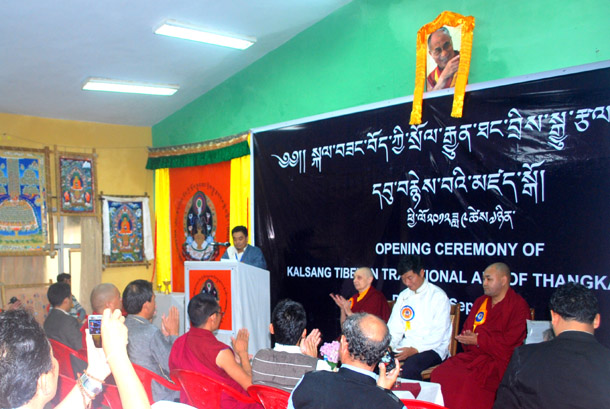
Dharamshala: In the late evening of September 7, Kalsang Tibetan Traditional Art of Thangka Painting opened its doors for the first time. The inauguration ceremony was held at the Club House Hotel in Mcleodganj, Dharamsala, northern India.
The chief guest for the evening, Kalon Tripa Dr Lobsang Sangay, and guest of honour Jetsunma Tenzin Palmo, head of Dhongyu Gatsel Ling Nunnery, unveiled the institution’s insignia and lit butter lamps, to commence the event. Soon after, there was a minute of silence in honour of those who have sacrificed their lives for Tibet.
The second chief guest of the evening, Deputy Speaker Khenpo Sonam Tenphel, and other members of the Tibetan Parliament-in-exile, attended the event, which hosted more than 250
guests, including representatives of various NGOs.
First up to the stage was Kalsang Dhamchoe, teacher at and director of the Kalsang Tibetan Traditional Art of Thangka Painting institute.
He began with a brief introduction to the traditional art of Thangka painting and went on to explain the urgent needs and reasons behind setting up such an institute.
“It is vital to know about the origins and history of traditional Thangka painting," he said. We need to know how and where the painting comes from - Its background and symbolism. It is also equally important to know, once the painting is created, where it is going - how to display and sell it correctly.”
Mr Kalsang explained that Thangka painting has a history that is deep and stretches across many generations. Each painting has many layers. True Thangka painting is not done commercially to produce large quantities that lack quality, he said, adding that each painting needs to be nothing short of perfection, there are rules to even selling and displaying such paintings, and that Thangka painting comes with great responsibilities.
Mr Kalsang talked about incidents in Tibet in which Thangka paintings, which were not up to the mark, were created and sold. “The creation and selling of such paintings is a result of insufficient knowledge on the creator’s behalf. It is the lack of advice they have on the rules and traditions of this art form.”
He then spoke about the 20 or more trainees at the institute. “Their experience in the field stretches from three years to 20. They all love to paint Thangkas and hopefully they will become professionals at it.”
Mr Kalsang ended his speech by stating that at the institute they have tried to embody the three basic principles of the 14th Kashag—Unity, Innovation and Self-reliance.
Dr Lobsang Sangay then picked up where Mr Kalsang left off, saying, “It is true that the Kalsang Tibetan Traditional Art of Thangka Painting is based along the lines of the three principles of the Kashag.
“All the trainees of the institute come from the three traditional provinces of Tibet. This shows unity. The institute takes this form of painting in a new direction while still staying true to its roots, displaying innovation. And lastly, self-reliance is demonstrated through the fact that, each of the trainees here can stand on their own two feet and look after themselves with taking up this age-old art form. “
The last speaker of the day was Khenpo Sonam Tenphel. He stressed that it was the responsibility of all such institutes to preserve and develop Thangka painting. On behalf of the Tibetan Parliament, he expressed great admiration towards Mr Kalsang for starting this endeavour.
“Kalsang Dhamchoe must be proud of himself," he said. "He has helped create an avenue to spread information about this traditional art form, with setting up the Kalsang Tibetan Traditional Art of Thangka Painting. I hope all gathered here will share what they have heard today about the need to preserve this form of art.”
The night ended with a dinner for all the attendees.


![Tibet has a rich history as a sovereign nation until the 1950s when it was invaded by China. [Photo: File]](/images/stories/Pics-2024/March/Tibet-Nation-1940s.jpg#joomlaImage://local-images/stories/Pics-2024/March/Tibet-Nation-1940s.jpg?width=1489&height=878)















